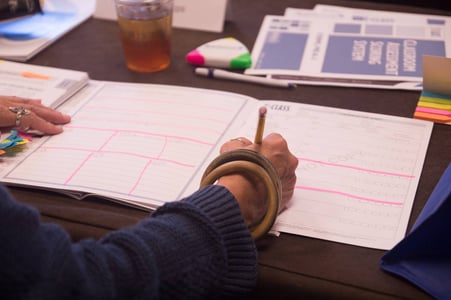
I’m a bit of what some would call a perfectionist. In school, I was devastated if I didn’t receive an A. In the swimming pool or in a regatta, first place was the only option. At work, my colleagues make fun of me and call me “a square” and make fun of me for “wearing a seatbelt” at my desk.
So you can imagine my surprise, disappointment, and shock when I received my first failing grade.
After almost three and a half years of working at Teachstone, I failed my pre-K CLASS re-certification test. Twice.
Yes, twice.
It was humiliating. As the Director of Product Marketing, I don’t spend my days immersed in the CLASS Manual or observing classrooms, but the CLASS domains and dimensions are a part of my everyday life whether it’s thinking through the goals of a new product or reviewing a colleague’s blog post. We strive to practice what we preach at Teachstone, providing strengths-based feedback and having meaningful conversations and engaging one another in learning. How could I show my face around the office—let alone support my team—if I couldn’t even do a simple thing like pass my recertification test?
Thanks to some coaching and support from colleagues, as well as a good deal of self-reflection, I walk away from this experience stronger and with three pieces of wisdom to share with others who are struggling to pass reliability:
- Remember what I said earlier about not immersing myself in the CLASS Manual or observing classrooms? Well, that was problem #1. That’s the whole point of training and certification! Practice makes perfect, and without a deep understanding of the manual and time spent observing and evaluating classrooms, one cannot succeed as a CLASS Observer. Many, many thanks to our awesome trainer, Curry Ander, who allowed me to join her training and refresh my CLASS knowledge.
- It’s not just about the test. The test is critical to ensuring that we only certify observers who can code fairly and reliably, but CLASS is about so much more. It’s about being able to identify and code those moment-to-moment interactions between teachers and children that make a lasting difference in children’s lives. There are lots of tricks one can use when taking a test (be honest, how many of you have never scored a 1 or a 7 on the test?); stepping into a classroom, however, requires a more holistic and nuanced approach to get fair scores and reports that can be used to give meaningful feedback and change teaching practice. A huge thank you to our partners at Westminster Child Care Center who allowed me to come and observe one of their classrooms.
- Failure is not just okay. It’s necessary. If I hadn’t failed my reliability test (twice), I would not have taken the time to really study the manual, to clarify the difference between Quality of Feedback and Concept Development, or to learn the difference between a mid-level Teacher Sensitivity score and a higher-level score. I am so much more confident in my CLASS knowledge today than I ever would have been with a simple PASS on Test 1.
I now know what so many of you are going through as you struggle through certification and recertification (and the anxiety leading up to these tests). My job did not depend on my passing this test, so I know the stakes are much higher for many of you. I do hope, however, that you will take these lessons to heart, seek support from Teachstone, and have faith in your own failure.
And in case you haven’t figured it out, third time (plus studying, coaching, and more studying) is a charm. I finally passed the CLASS reliability test and look forward to receiving my certification card and sharing it proudly the next time I observe!

